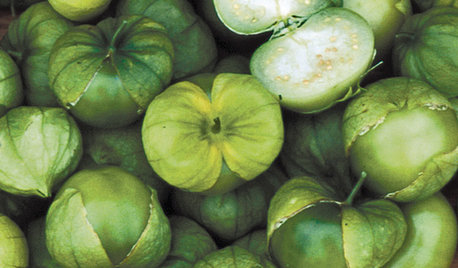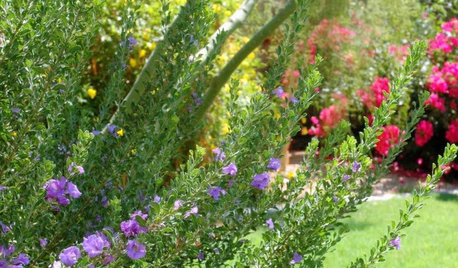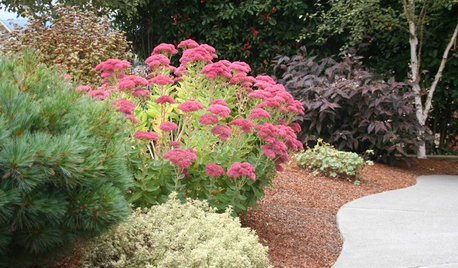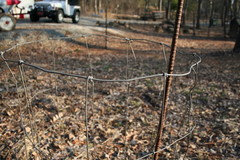how do you stake tomatoes?
kawaiineko_gardener
14 years ago
Featured Answer
Sort by:Oldest
Comments (19)
windclimber
14 years agolast modified: 9 years agohardclay7a
14 years agolast modified: 9 years agoRelated Discussions
How do you stake baby seedling vines?
Comments (14)That's an excellent question, Karyn. Frst time I started vines inside I wound up having to relegate one entire light fixture just for their growth because I ran into just the same problem. Pity since at that time I only had maybe three or four different vines going and felt like I was wasting precious "light space". But at least now I'm doing more than a few vines at a time so I don't feel so badly. When I transplant them from cells (or plugs) into 3" pots I'll stick the skewer (yeah, I use them too) all the way down to the bottom of the pot and raise it as the vine grows. As long as the top of the vine is no more than 2-3" away from the light source, they're fine. When the skewer is lengthened as high as possible w/o tipping over, then it's generally time to move them out to the greenhouse where I'll carefully insert another, taller skewer and attach it with a sliver of of old panty hose. If you can't do that, then you may have to do what I did and just relegate one light source for just the vines alone. Linda...See Moreshow me how you trellis/stake/handcuff your tomatoes :)
Comments (2)Tip: To see a lot of tomato trellis photos and get ideas, just google "tomato trellis" and hit the images button at the top of the page. Tom- I can't wait to see version 4.0....See MoreTime to stake/cage... what do you do?( probably been discussed)
Comments (13)I use cages, as they are the least amount of work. Specifically, I use the Texas Tomato cages and will never use anything else, personally. While they are expensive, they are worth it - provided you plan on growing a fair number of plants for years and years - they will last much longer than most improvised cages, they store very well (they fold flat). As far as staking goes, I've tried that for many years, thinking it was the cheapest / only option... For the big indeterminates it was a nightmare. You either needed to prune / tie like crazy, reducing yield and spending lots of time, or the plants would be essentially sprawling in a very short amount of time. As far as CRW cages and PVC cages, the materials do still cost money and my understanding is that they only generally last a few seasons at best. The big issue I have is that I don't have the room to store those types of cages. I have a fair amount of land, but not enough that I can leave a pile of cages in the back of my yard and not hear about it from the neighbors. Florida weave is a good middle ground alternative for training plants. It's still a little bit of work since you need to buy / install posts and run twine regularly, but it's much better than traditional staking. As I said, though, I prefer cages to everything I've done so far, but to each his own. The idea that I can re-use and easily store my cages for a decade or more is very appealing to me since I plan to have a garden as long as I have the physical ability to do so....See MoreHow to best stake older, taller tomatoes?
Comments (5)Driving a stake into the center of an older plant is a good way to kill the plant. No way you can keep from damaging the roots. Instead drive a couple of stakes well out on the outside of the wire cages and tie the cages to those stakes. The plant can drape over the cage with no problems or you can tie string or wire between the 2 stakes on the cage and tie off branches to that. Next year consider using quality CRW cages and stake them down at planting time when you don't have to worry about root damage. An 8' tall plant does just fine in a 5-6' CRW cage. Lots of discussions here about them and how to make them. Dave...See Moretedsfarms
14 years agolast modified: 9 years agolarenatc
14 years agolast modified: 9 years agogrow-anything
14 years agolast modified: 9 years agolarryw
14 years agolast modified: 9 years agoarcherb
14 years agolast modified: 9 years agospiced_ham
14 years agolast modified: 9 years agodaylilyfanatic4
14 years agolast modified: 9 years agoreadheads
14 years agolast modified: 9 years agolarryw
14 years agolast modified: 9 years agodigdirt2
14 years agolast modified: 9 years agowordwiz
14 years agolast modified: 9 years agotn_veggie_gardner
14 years agolast modified: 9 years agoreadheads
14 years agolast modified: 9 years agojunktruck
14 years agolast modified: 9 years agodaniele_grow
14 years agolast modified: 9 years agonatal
14 years agolast modified: 9 years ago
Related Stories

LIFEEasy Green: Modern Homesteaders Stake a Claim
With more options for raising chickens, growing edibles and keeping bees than ever, suburban and city folk are rediscovering a lost art
Full Story
EDIBLE GARDENSSummer Crops: How to Grow Tomatoes
Plant tomato seedlings in spring for one of the best tastes of summer, fresh from your backyard
Full Story
GARDENING GUIDESCommon Myths That May Be Hurting Your Garden
Discover the truth about fertilizer, soil, staking and more to keep your plants healthy and happy
Full Story
MOST POPULARThe Unexpected Color That Goes With Everything
Move over, beige. Green is staking its claim as the freshest neutral around
Full Story
SUMMER FRUITS AND VEGETABLESSummer Crops: How to Grow Tomatillos
Grow this Mexican native for the freshest salsa verde — and for fewer problems than its tomato cousins
Full Story0

GARDENING GUIDESCalifornia Gardener's June Checklist
Update your hydrangeas, catch up on tomatoes and more ways to enjoy your California garden in June
Full Story
GARDENING GUIDESSouthwest Gardener's June Checklist
Protect your plants from too much sun while waiting for rain relief, and guess what? Those cacti might need a drink
Full Story
GARDENING GUIDESCalifornia Gardener: What to Do in July
Active green thumb or not, top priorities for peak fruit and veggie season: watering, feeding, keeping up with growth
Full Story
GARDENING GUIDESPacific Northwest Gardener's August Checklist
Deadheading perennials, cutting raspberry canes and preparing for the onion harvest keeps Northwest gardeners busy in August
Full Story
GARDENING AND LANDSCAPINGBuild a Raised Bed to Elevate Your Garden
A bounty of homegrown vegetables is easier than you think with a DIY raised garden bed to house just the right mix of soils
Full StorySponsored





digdirt2